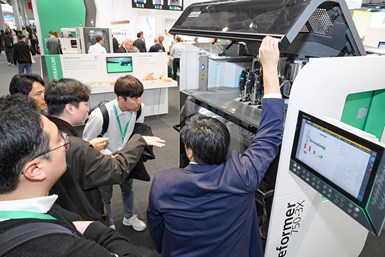Arburg Develops High-Temperature Version of Freeformer 750-3X for Polymer 3D Printing
The machine is well suited for the manufacture of geometrically intricate polymer parts that require high-temperature production.
A high-temperature version of the new Freeformer 750-3X can additively manufacture ventilation ducts for the aerospace industry from Ultem 9085 original plastic granules. Photo Credit: Arburg
Arburg has developed a high-temperature version of its Freeformer 750-3X which can process Ultem 9085 original plastic granules. The build chamber can be tempered to 200°C, with plastification of the plastic granules taking place at up to 450°C. In comparison, the maximum temperature of the build chamber in the standard Freeformer 750-3x is 120°C.
The machine is well suited for the manufacture of geometrically intricate parts such as air distributors (ventilation ducts) for aerospace manufactured from original Ultem 9085 granulate. Ultem is just one example of a 3D printed polymer that requires high-temperature production.
The Freeformer 750-3X 3D is designed as an open system utilizing the Arburg Plastic Freeforming (APF) process for custom-configured additve manufacturing (AM). The system is said to meet individual user requirements by adjusting slicing, droplet size and process regulation to influence the layer-by-layer build process utilizing a broad range of materials.
The APF process is a unique AM material jetting method. In APF, a thermoplastic material is supplied as pellets, melted and selectively deposited as droplets, enabling the use of commercial materials in their original shape instead of filaments.
The 750-3X features a large build chamber which is approximately 2.5 times larger than that of the Freeformer 300-3X. It is well suited for the rapid series production of large components or several articles per construction order. Its printing and space configuration are optimized. The principle of material preparation remains the same in the Freeformer 750-3X, but the entire system — preparation and discharge units — has been optimized so the unit could be designed more compactly. From a strictly external point of view, the machine cannot be distinguished from the 300-3X, as it has the same external dimensions. However, the part carrier is around 2.5 times larger at around 750 m3.
The larger build chamber measures 330 × 230 × 230 mm. The temperatures are kept stable without any special air flow or circulation as a result of several technical innovations. These include melt pressure generators for dosing and injecting, which use servo motors from AMKmotion (an Arburg company). This enables the three discharge units to be positioned more closely to each other and in a more compact way. Due to advanced software features of the control system, it is possible to increase the printing speed considerably. For example, process-optimized latticed support structures can be created where the build time is up to 55% faster than with conventionally constructed ones, the company says.
- Learn more about Arburg’s Freeformer printers, including the 750-3X 3D which features a larger build chamber. The Freeformer 750-3X 3D provides more space inside the build chamber for larger components.
- Read about Arburg’s Compact TiQ 5 Pro which offers versatile 3D printing for fiber-reinforced filaments. The TiQ 2 is particularly economical and well suited as an entry-level additive manufacturing solution because of its open material system.
Related Content
Airless Basketball Shows Promise of 3D Printed Lattices: The Cool Parts Show Bonus
Successfully matching the performance of a standard basketball demonstrates the control possible over the mechanical properties of digital materials.
Read MoreThis Drone Bird with 3D Printed Parts Mimics a Peregrine Falcon: The Cool Parts Show #66
The Drone Bird Company has developed aircraft that mimic birds of prey to scare off problem birds. The drones feature 3D printed fuselages made by Parts on Demand from ALM materials.
Read MoreQ&A With Align EVP: Why the Invisalign Manufacturer Acquired Cubicure, and the Future of Personalized Orthodontics
Align Technology produces nearly 1 million unique aligner parts per day. Its acquisition of technology supplier Cubicure in January supports demand for 3D printed tooling and direct printed orthodontic devices at mass scale.
Read MoreWhat Does Additive Manufacturing Readiness Look Like?
The promise of distributed manufacturing is alluring, but to get there AM first needs to master scale production. GKN Additive’s Michigan facility illustrates what the journey might look like.
Read MoreRead Next
Crushable Lattices: The Lightweight Structures That Will Protect an Interplanetary Payload
NASA uses laser powder bed fusion plus chemical etching to create the lattice forms engineered to keep Mars rocks safe during a crash landing on Earth.
Read MoreBike Manufacturer Uses Additive Manufacturing to Create Lighter, More Complex, Customized Parts
Titanium bike frame manufacturer Hanglun Technology mixes precision casting with 3D printing to create bikes that offer increased speed and reduced turbulence during long-distance rides, offering a smoother, faster and more efficient cycling experience.
Read MorePostprocessing Steps and Costs for Metal 3D Printing
When your metal part is done 3D printing, you just pull it out of the machine and start using it, right? Not exactly.
Read More






















